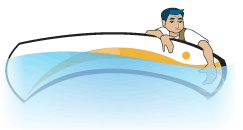Preventing and Surviving Boats Capsizing and Falls Overboard
Boat Capsizing and Falls Overboard
Did you know that the major cause of fatalities in small boats is from drowning after a fall overboard or a capsizing? And according to the U.S. Coast Guard, eighty-five percent of people who drown while boating are not wearing a lifejacket.
So the number one way you can be prepared for these potentially deadly emergencies is to always wear your lifejacket.
What else can you do to be prepared?
Let's start by learning more about these emergencies and their causes.
A capsizing is when a boat overturns or is swamped with water. Capsizing occurs most often with small boats like canoes and sailboats. One of the good things is that these small boats usually stay afloat, giving the boaters who are now in the water something to hold onto for support.
Common causes of falls overboard and boat capsizing include: being caught off guard by a wave or sharp turn when moving around in the boat, carrying too much weight in the boat or unevenly distributing weight in the boat; and bad weather conditions.
Prevention of Boat Capsizing and Falls Overboard
Knowing this, there are a few things we can do to prevent these emergencies.

- First, stay low and centered in your boat, and always maintain three points of contact when moving about your boat.
- Second, take corners at a safe speed and angle.
- Third, watch for other boats' wake and take that wake head-on from the bow.
If you must boat in bad weather, make sure to slow down.
A final tip is to never tie the rode line of the anchor to the stern of your boat. This places more weight at the back of the boat, increasing chances of capsizing, or swamping, your boat.
What to Do If a Passenger Falls Overboard
If you're operating a boat and a passenger falls overboard, here's what to do:
Step 1: Immediately slow down and stop the boat.
Step 2: Quickly throw something buoyant, like a life buoy or a lifejacket, to the person overboard. This will help them stay afloat and mark their location in the water if they go under.
Step 3: Assign someone in your boat to keep the overboard person in sight at all times. Have them continually point to the person's location in the water.
Step 4: Carefully position the boat close enough to make contact with the overboard person. Keep them on the operator side of the boat.
Step 5: Throw a buoyant heaving line, or a life buoy attached to your boat, to the person overboard.
Step 6: Pull the overboard person to your boat and get them back on board using the boat's boarding ladder. If your boat doesn't have a ladder, you can drape a heavy rope or chain across the stern to use as a makeshift step.
It's important to consider that in most instances, the overboard person will climb back into the boat from the stern. To avoid a second emergency, turn off your engine.
How to Survive If Your Boat Capsized or You Fall Overboard
If you don't have a capacity plate on your boat—which may be the case if you're operating a small, flat-bottomed boat—you can calculate the largest safe engine size in the following way.
- First, stay calm and conserve energy.
- If you were boating with others, take a headcount and make sure everyone is accounted for. Stay together.
- If possible, re-board your boat.
- Stay with your boat unless it's headed for a hazard. Small boats tend to float; by holding on to your boat, you will help conserve energy and remain more visible to other boaters who can come to your rescue.
- When separated from your boat in a fast-moving river, float on your back with your feet pointed downstream.
- And most important, get out of the water as quickly as possible.
Falls overboard and capsizing show how important it is to wear a lifejacket. If you end up in the water, your lifejacket will help you conserve energy, stay warm and keep afloat while you wait for rescue.

